 Shalwar kameez is the dress worn by both men and women in South Asia and Central Asia. It is a unisex dress similar in manner to shirt and pants worn by westerners. The phrase shalwar kameez is a generic term used to describe different costumes which have been developed in different regions (the Sindhi Suthan; Kashmiri Suthan, the Dogri pyjama). Traditionally, it has been worn in Afghanistan, Pakistan and in Northern India. The popular type of shalwar kameez known in the sub-continent has roots in the pre-partition Punjab.
Shalwar kameez is the dress worn by both men and women in South Asia and Central Asia. It is a unisex dress similar in manner to shirt and pants worn by westerners. The phrase shalwar kameez is a generic term used to describe different costumes which have been developed in different regions (the Sindhi Suthan; Kashmiri Suthan, the Dogri pyjama). Traditionally, it has been worn in Afghanistan, Pakistan and in Northern India. The popular type of shalwar kameez known in the sub-continent has roots in the pre-partition Punjab.Since the 20th century, women in Southern India have also copied this dress complementing the Sari, the traditional dress of India. The Shalwar or Salwar (as pronounced in India) is a loosely-fit pajama-like pant. The legs are often wide at the top, and narrow at the ankle, although there are several styles of shalwar pants in modern times, some trendy and jean-like. The kameez is a long shirt of tunic length which hits at the middle of the thigh, but traditionally, it would come down to the top of the knee. The side seams (known as the chaak), left open below the waist-line, give the wearer greater freedom of movement. On a female, the shalwar kameez ensemble is completed by wearing a dupatta (loose scarf) around the shoulders, draping over the chest.
 Shalwar are gathered at the waist and held up by a drawstring or an elastic band. The pants can be wide and baggy or more narrow, and even made of fabric cut on the bias.
Shalwar are gathered at the waist and held up by a drawstring or an elastic band. The pants can be wide and baggy or more narrow, and even made of fabric cut on the bias.The kameez is usually cut straight and flat; older kamees use traditional cuts, as shown in the illustration above. Modern kamees are more likely to have European-inspired set-in sleeves. The neckline, sleeves and bottom edge (daaman) are many times decorated with embroidery or laces.
For women, an integral part of shalwar kamees is the dupatta — a long shawl wrapped around body or to cover head in more conservative families. The shalwar kamees fashion has revolved around the cuts and lengths of shalwar and of kamees and the print styles and color palette of the dupatta. Most women in Afganistan were forced to hide their faces even when wearing a shalwar kameez by the Talibans
In Britain, especially during the last two decades, the garment has been transformed from an everyday garment worn by immigrant South Asian women to one with mainstream, and even high-fashion, appeal.Garments cut like the traditional kameez are known in many cultures; according to Dorothy Burnham, of the Royal Ontario Museum, the "seamless shirt," woven in one piece on warp-weighted looms, was superseded in early Roman times by cloth woven on vertical looms and carefully pieced so as not to waste any cloth. 10th century cotton shirts recovered from the Egyptian desert are cut much like the traditional kameez or the contemporary Egyptian jellabah or galabia.The shirt, kameez or qamiz, takes its name from the Arabic qamis.
 Luxury Embroidered Shalwar Kameez
Luxury Embroidered Shalwar Kameez Green vs Purple Shalwar Kameez
Green vs Purple Shalwar Kameez Beautiful and Luxury Shalwar Kameez
Beautiful and Luxury Shalwar Kameez Elegant Red and Black Shalwar Kameez
Elegant Red and Black Shalwar Kameez Great Red and Green Combination Shalwar Kameez
Great Red and Green Combination Shalwar Kameez Shalwar Kameez with Ethnic Motif
Shalwar Kameez with Ethnic Motif Gold and Red Shalwar Kameez
Gold and Red Shalwar Kameez Simple Red Shalwar Kameez
Simple Red Shalwar Kameez Full Embroidered Shalwar Kameez
Full Embroidered Shalwar Kameez







































